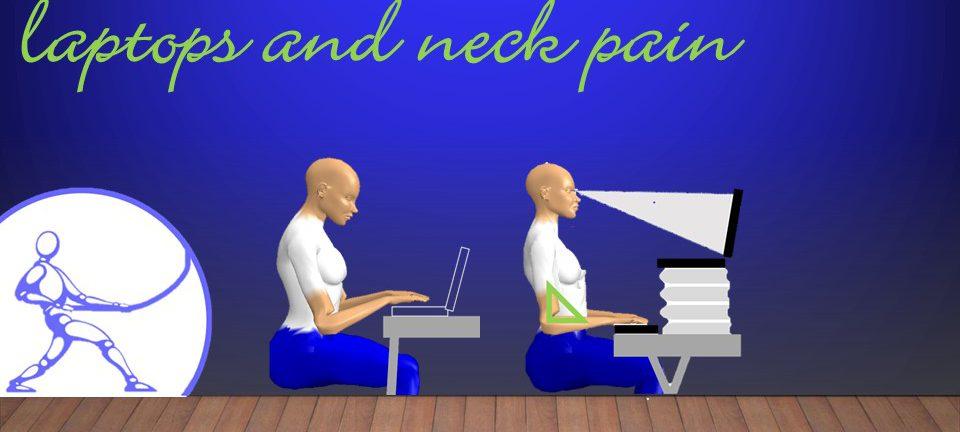by Kirsten Fradgley
Did you know that 71% of Canadians own a laptop, and the average Canadian spends 4.2 hours every day using a laptop? Some of us spend 8 hours every day, working on a laptop for work. The continuous use of a laptop in a conventional desk set up (laptop placed on top of a desk or table) is associated with an increased risk of neck and shoulder discomfort and musculoskeletal disorders (MSDs). The purpose of a laptop is to be lightweight and portable. Laptops are designed to benefit the work environment, allowing workers to travel with a computer; however, they were not designed to fit the users’ body.
How can the laptop design hurt your neck?
The laptop screen and the keyboard are attached, so it’s easy to fold up for travel. Because of this design, the screen is usually below eye height. The lower screen forces the user to bend the head forward into an awkward position.
The source of neck pain
Bending your head forward can increase the pressure on the front portion of your spine, and stretch the muscles at the back of the neck. The average human head weighs about 12 pounds (the weight of a bowling ball). When the head is upright, this weight is evenly distributed on the spine, and the muscles at the back of the neck are shorter and more relaxed. When the head is bent forward, the weight of the head shifts to the front of the spine, and pulls the muscles at the back of the head, stretching them. The muscles at the back of your head now must work harder to hold your head in the bent position.
Laptop use and musculoskeletal disorders MSDs
Holding this awkward neck position for long periods can make the muscles at the back of the neck tired. Chronically tired muscles can lead to neck discomfort, and can increase the risk of developing musculoskeletal disorders.
A study from 2020 found that laptop computer users with a conventional laptop set up (laptop placed on top of a desk) bent the head forward more than those using a conventional computer arrangement that was adjusted to fit the user. The muscles at the back of the neck were more active (working harder). The laptop users also rated their neck discomfort higher.
Asking your ergonomist for help
Laptops allow users to work at home, in a vehicle, or even at the lake! You don’t have to give up the benefits of a laptop because of neck discomfort. There are many solutions that will help you to set up your workspace, ergonomically. A laptop stand, external keyboard and mouse, or external monitors can be used to improve neck postures. Ask an ergonomist for help with setting up a laptop desk!
Resources:
Mohammad Yadegaripour, Malihe Hadadnezhad, Ali Abbasi, Fereshteh Eftekhari & Afshin Samani (2021) The Effect of Adjusting Screen Height and Keyboard Placement on Neck and Back Discomfort, Posture, and Muscle Activities during Laptop Work, International Journal of Human–Computer Interaction, 37:5, 459-469.
Osama, M., Ali, S., & Malik, R. J. (2018). Posture related musculoskeletal discomfort and its association with computer use among university students. J Pak Med Assoc, 68(4), 639-641.
Asundi, K., Odell, D., Luce, A., & Dennerlein, J. T. (2012). Changes in posture through the use of simple inclines with notebook computers placed on a standard desk. Applied ergonomics, 43(2), 400-407.
Government of Canada, S. C. (2017, November 14). The internet and digital technology. Government of Canada, Statistics Canada. https://www150.statcan.gc.ca/n1/pub/11-627-m/11-627-m2017032-eng.htm.
Help with laptops from Taylor’d Ergo:
Training to help set up home offices
Bought a sit/stand desk? E-learning to ensure that you get the most value out of sit/stand desks


